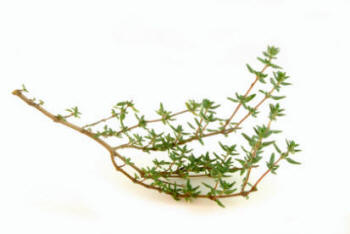Thyme – Thymus Vulgaris
Thyme has been hugely popular since Romans times; they thought it was a remedy for melancholy and the Greeks thought thyme was an emblem of courage, but Thyme was also greatly appreciated by both for its scent.
It was a great honour if you where complimented that you smelled of thyme. Thymus is the original Greek name.
Thyme has more than 350 different varieties, many hybrids (a plant produced from a crossing between plants) and cultivars (a variety of a cultivated plant that is developed by breeding and has a designated name).
There are many synonyms (words meaning same as another) and invalid names. The main varieties for medicinal uses are T. vulgaris and T. serpyllum, for culinary use T. vulgaris and T. X Atriodorus, these two have the best flavour, although many others are used.
Growing Thymes
 The Herbal Thymes - Thymus vulgaris and Thymus serpyllum, have several
variations by way of bred cultivars which are more attractive - or at
least different - from the basic parent.
The Herbal Thymes - Thymus vulgaris and Thymus serpyllum, have several
variations by way of bred cultivars which are more attractive - or at
least different - from the basic parent.
The cultivars can also be used in culinary and - as far as we are aware - herbal medicine uses.
Some of the popular thyme varieties: (Wild thyme) also known as the mother of thyme has wonderful clusters of mauve to pink flowers that appear in early summer with dark green ovate leaves.
Thymus - Thymes - are legendary for their ability to grow in cracks in paving, gravel paths, dry stone walls and many more seemingly inhospitable places.
The Thymus serpyllum types are also at home if being trodden on from time to time, so there is no need to worry about damage - other than slight bruising of the foliage, and spoiling of the flowers if flowering at the time. This flexibility allows for Thymes to be used in any dry situation - rarely needing watering, so eminently suited to dry garden projects and also in terracotta pots and troughs. Old sinks - if they are available, seem to have been made with thyme in mind.
They do not seem to do well in hanging baskets - nor window boxes - needing a little watering from time to time. I suspect that this is because of the loose nature of the soil in such containers - or the fact that a peat compost was used in preference to garden soil.
If all this does not tempt you to Thymes, then also bear in mind that they are virtually free of all insect pests, whilst at the same time attractive useful flying insects - and bees in particular. They are also evergreen and mostly fully hardy - especially if planted in a dry spot. Cold winter wet is their worst enemy.
Propagation of Thyme
Thymus are so easy to propagate - so much so, that the lower growing types do the job for you. Their lower shoots often rooting wherever they touch the ground. Quite easy with the taller growing varieties. Simply peg a few shoots down to ground level and they will root in a month or so.
If you really want to go at it, then take short cuttings - either in late spring, early summer or September, and root in a greenhouse or coldframe.
(Common
thyme) with its tall woody stems, dark green leaves and white or mauve
flowers.
(Lemon thyme) As its name suggests it has highly lemon scented leaves
and pale mauve flowers.
(Pink chintz) is creeping thyme with grey foliage and beautiful bright-
pink flowers.
Thyme requires free-draining soil and a sunny position, the ones mentioned above are hardy in cool temperatures, but they may need protection in the winter. Propagate by cuttings in the summer of seed in the spring.
Medicinal
Thyme can be used as an infusion to treat coughs, colds and chest infections
and also digestive upsets, in syrup form it is soothing for sore throats as
thyme is an antiseptic, antibacterial and antifungal herb. The essential oil can
be used as a rub for chest infections or as massage oil for aching joints of
rheumatic pain. Thyme is also used to treat athlete’s foot.
Culinary
Thyme leaves can be used fresh or dried to add wonderful flavour to many
recipes, combine thyme with other herbs and make a bouquet garni, (herbs tied
together and added to soups and stews). Thyme is a great favourite in French
cuisine and blends beautifully with garlic. Use lemon and orange thyme leaves
and add to olive oil, it makes a superb marinade. Add thyme to cheeses and try
orange thyme in honey is makes a wonderful spread. Try to use as many different
thyme varieties as you can, for their vast flavours.
Best Selling Gardening Products
Popular Gardening Sections

Problems
Identify Weeds in The Garden - How to deal with weeds. Diseases and Pest which harm your garden and plants, learn how to prevent, deter and erradicate your garden problems.
Garden Problems
Pruning
Pruning Guide. Shrubs flower better with correct pruning. Many illustrations and examples of what to do - and when. Includes evergreens, roses, flowering shrubs, spring flowering shrubs and pruning for stem effect. This is our most viewed and comprehensive section,
Pruning
Gardening Businesses
Gardening Businesses listed in the UK counties and USA states. County and State Listings of businesses involved in Garden supplies and services. If you wish to be added to the Directory, please send us your information. Having problems, use the search box
Businesses
Gardening
In this section you will learn about Gardening Basics, Containers, Landscaping, Propagation and Soil.
Gardening
Gardening Gifts
Gardening Gifts and Reviews, Read Before you Buy
- Gardening Gifts Ideas
- Gifts For Her
- Gifts For Men
- Power Tool Gifts
- Cheap Gifts
- Personalised Gifts
- Wildlife Gifts
- Family Gifts



